The Cliff House Mystery
by: Lynn E. McElfresh
Most neighborhoods have one, that one derelict house that looks and feels creepy. If it’s empty, the longer it stands, the more the stories grow and everyone wonders . . . is it haunted?
Islands are no exceptions. And once upon a time in our island neighborhood, right across the water from us at the foot of Murray Isle was a deserted hotel. If it were still standing today, I’d be able to see it from my bedroom window.
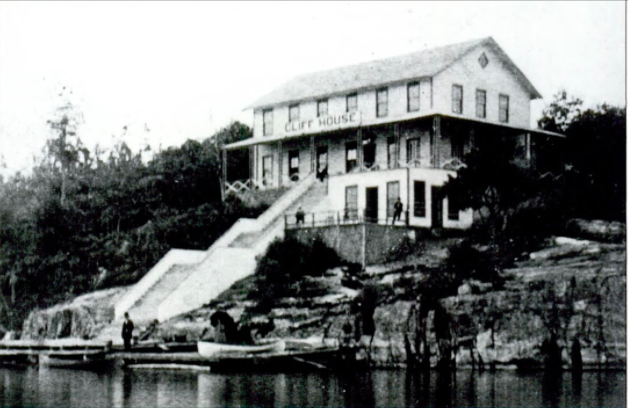
From the very beginning, Cliff House was a mystery. All agree that Elisha Garrison came to the river and had the hotel built near the Narrows at the foot of then Hemlock Island (now Murray Isle) but everything else seems to be in question. Some say it was built in 1877, others say 1878. Some say that Garrison had been the proprietor of a hotel in Oswego; others claim he previously ran the Vanderbilt House in Syracuse. Still, others said that he had no hotel experience at all but that Elisha had been a Central New York Railroad conductor. However, no one disputes that the hotel was an instant success.
Perched high on the rocks and painted a dazzling white, Cliff House was known for lively entertainment with lots of laughter and song. The view alone was worth the climb up the wide, steep staircase that connected the landing to the covered main floor porch. While not a huge hotel, it was well-appointed. The fixtures, furnishings, tableware, glassware and deep pile Brussel carpets were all first class. A letter to the editor in 1891 claimed that: “At no place on the river, either before or since his time, has it been possible to get bar entertainment of better quality or served in any more attractive style than that provided by Mr. Garrison.” Elsewhere, it was reported that the hotel cleared $3,000 its first season—and that’s when the average wage earner only brought home around $435 in a year. A very good first season indeed.
Elisha was joined in this venture by his wife, described as “a very estimable and popular lady” and a daughter who was “beautiful and accomplished.” Elisha himself was described as “a true gentleman.” It seemed the perfect family.
The bar was located on the first floor (or basement) of the establishment along with a large zinc-lined cooler called the milk room. On the main floor, guests would find the office, parlor, dining room, reading room, kitchen, one bedroom, which presumably belonged to the Garrisons, and a cave-like structure built into the hillside, evidently used as a refrigerator. The top floor was home to nine guest rooms.
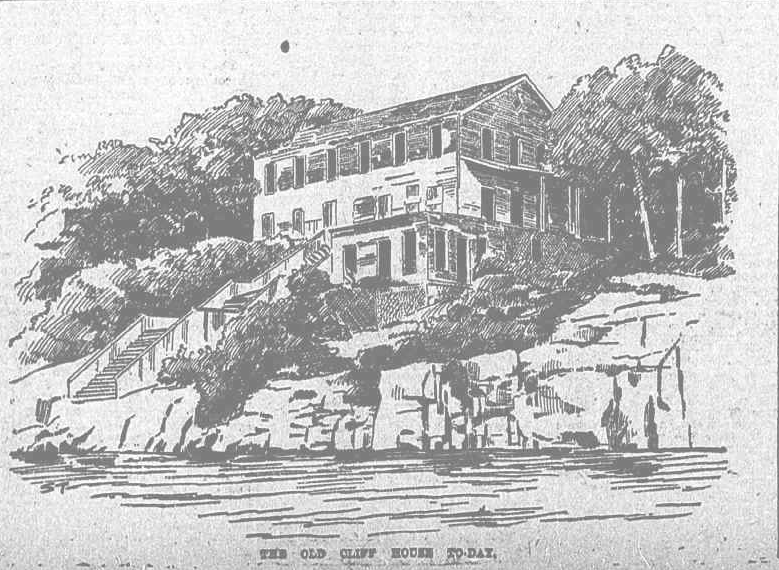
By all accounts, Cliff House was a popular place. And then one day—again no one is sure of the year, maybe 1882 or 1883—the Garrison’s packed a few things into a boat, headed for the mainland, and never returned. The doors to Cliff House were left open. To those who stopped by, it looked as if the Garrisons had stepped out for a few moments and would return shortly. In the kitchen, all the dishes and utensils remained. Pictures were left framed on the wall, the parlors and guest rooms still had various knick-knacks sitting about. In the office, an ink bottle and pen sat beside the guest register.
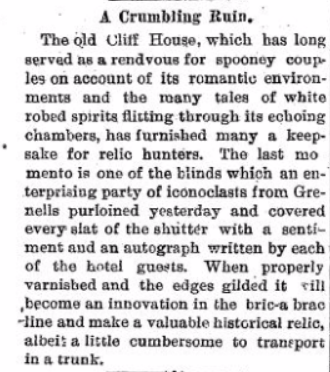
The Cliff House became a curiosity. Islanders from far and near flocked to the deserted hotel to wander through the furnished rooms. Many signed the guest register. Eventually, the guest register along with the dishes and pieces of furniture disappeared. With no guest register to sign, interlopers started signing the walls. Soon everything in the once stately hotel was covered in graffiti, even the slates on the shutters.
As the years wore on, vandalism increased. Windows were broken. Even the partitions between the guest rooms were torn out and carted away. With the windows gone, leaves collected in huge piles over the once fine, deep-pile carpeting. Pictures molded and fell from their frames. Doors dangled precariously from one hinge.
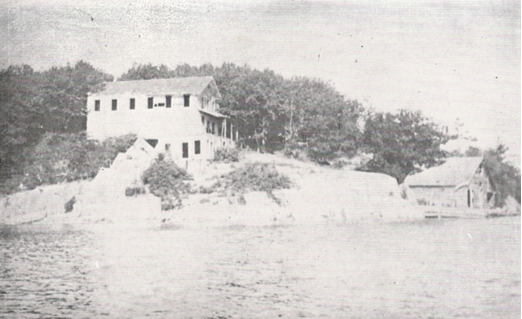
Trespassers’ accounts sometimes made it into the newspaper like this 1896 Watertown Reunion article: “weird atmosphere in the closed and musty rooms, some of which are so dark that a match will not illuminate the interior and in others, the air is so damp that match after match when ignited will flicker and go out.”
By 1896, the dock at the base of the rock was swept away by winter storms. Nothing remained but a pile of stones and timbers. The once broad stairway leading to a porch was so dilapidated that it was impossible to traverse.
On a moonlit night, the white building glowed like a ghost, its dark windows staring out at the water like vacant eyes. Electric searchlight tours came into vogue in 1889, and as the number of searchlight tours increased, so did the stories about the haunted Cliff House. Stormy or moonlit nights feature strongly in the many haunted legends. Onlookers swore that during storms, there were strange lights and figures in old time garb flitting about the windows.
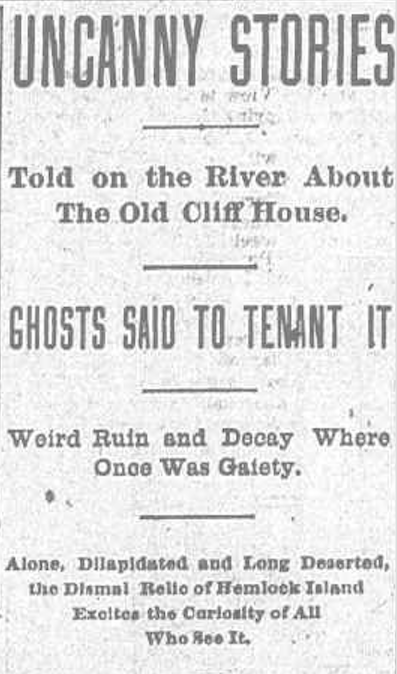
Some of the “ghosts” were clearly pranks as this 1891 On the St. Lawrence article describes: “A party of campers visited the place in 1890. In an upper room, they saw something all in white moaning and wringing its hands. All fled in terror, but it was afterward found out that the ‘ghost’ was one of the young men of the party, who had wrapped himself in a sheet to test his companions’ haunted skepticism.” Colonel Watson, a Murray Isle resident whose property was nearby, also admitted to dressing in a sheet on occasion and scaring away parties of young people.
There was also this first-hand account in an 1896 Watertown Reunion article: “An old fisherman named Ryan appeared at a nearby cottage one morning, his face drawn and pinched, shaking in every limb and said he had spent the night in a room of the Cliff House and had been nearly strangled by invisible hands. He had according to his story, been drinking quite freely and while wandering over the island in search of a resting place, he drifted into the disused kitchen of the hotel. He was awakened by a curious sensation and though the room was pitch dark, felt the presence of another being near him. Gradually the bony outline of a mummified hand developed in the darkness. It drew nearer and nearer until it seized him by the throat and despite his efforts to rise, thrust him back on a pile of leaves. When he recovered consciousness, daylight was streaming in and he quickly made his escape. To substantiate his story, he showed the marks of the fingers around his neck, but some stubborn unbelievers insisted he had suffered from an attack of delirium tremens and in his agony clutched his own throat.”
Here are the most oft-repeated legends.
Legend 1: Murder
An 1891 On the St. Lawrence article quotes a tour guide as saying “Why they say the hotel keeper murdered his wife and child and ran away, and no one has occupied it since.”
Legend 2: Marauders
An 1896 Watertown Reunion article claimed that the disembodied spirits of a number of river marauders haunt the area. “It was near this spot that Captain Litts and his famous band are said to have had their camp and back of the house near a ledge of rock it is said they buried their treasures.” (His band was not that famous because I’ve never found any mention of Captain Litts or his band other than in this one newspaper article.)
Legend 3: The Handyman & Watermelons
While the hotel was still open, a handyman who worked there broke into the storehouse and stole two watermelons and ate them both. He developed colic and died. This apparition was said to be seen during storms when his form floated in and out of the storeroom.
Legend 4: Drowned Babies
Another tale claims a woman threw three babies down the well located in the back of the Cliff House. The letter to the editor in 1891 dispelled this story saying that there was no well and that, “The St. Lawrence River flowing as it does along the base of the crag on which the house was built, furnished all the water needed for every purpose.”
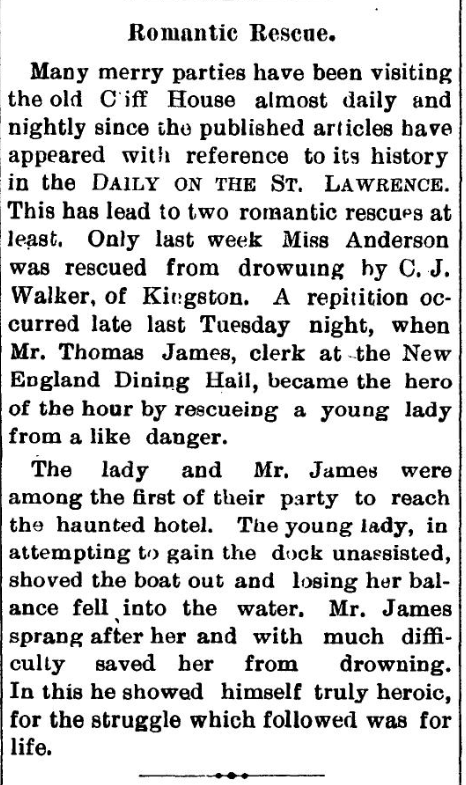
Legend 5: Moonlight & the 4th Window
The most detailed legend about Cliff House appeared in an 1891 On the St. Lawrence article and combines many of the legends into one. It claimed the ghostly visitations occurred “when the full moon shines bright and the rays strike direct through the fourth window on the northeastern side of the old house, and casts a long moonbeam through the corridor on the second floor. For the space of some ten minutes, the ghostly procession can be seen by any person bold and daring enough to take a position on the stairs in one of the many chambers on the second floor. First comes the handyman who stole the watermelon, who “marches along with a heavy tread balancing an immense melon on his head, his face buried in the half of another and at intervals, as he grinds at the melon uttering most unearthly groans. He is followed generally by a beautiful young lady, who sobs as if her heart would break, and constantly wrings her hands, with a large glistening diamond on the thumb of her left hand; then come three little children, leading each other, their auburn locks dripping with water and moss, and tiny little green flags are interwoven in their dark tresses.”
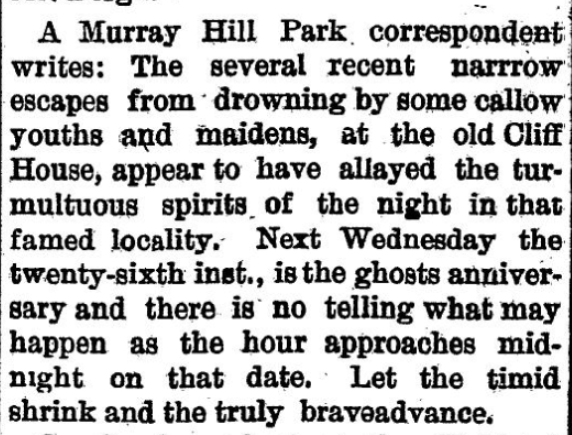
"Real" Ghosts
I find it odd that there were no newspaper accounts about the death of the handyman or the babies. The only newspaper accounts of deaths associated with Cliff House were of the Eel Bay catastrophe. In November of 1881, the caretaker of Cliff House, his wife, and two young children were drowned along with the caretaker and family of Hub House. The two families left from Cliff House, one blustery day headed for Gananoque. Almost as soon as they passed through the Narrows, their sailing skiff overturned in Eel Bay. If the Cliff House were haunted, my vote would be that it was the drowned caretaker’s family. Could it be the ghosts of the two families last seen at Cliff House that fateful day in 1881 caused the Garrison family to desert the property in 1882 or 1883?
The Garrisons
In truth, it was probably not ghosts, but financial troubles that caused the Garrisons to walk away from their hotel and never return. Again, there are conflicting stories as to what happened to the Garrisons after they left Cliff House. Some say Elisha became a conductor on the express train between Niagara Falls and Clayton. Others say it was on the Rome, Watertown and Ogdensburg Railroad. Still, other accounts report that the Garrisons moved to Washington State. There is no definitive answer.
Fire
In August 1893, Daily on the St. Lawrence reported: “some boys built a campfire in the old ice house and went off and left it. The flames spread in the sawdust and were commencing to eat up the structure when somebody discovered the blaze. The cottagers nearby rallied and extinguished the fire” The old Cliff House was saved only to be torn down a few years later.
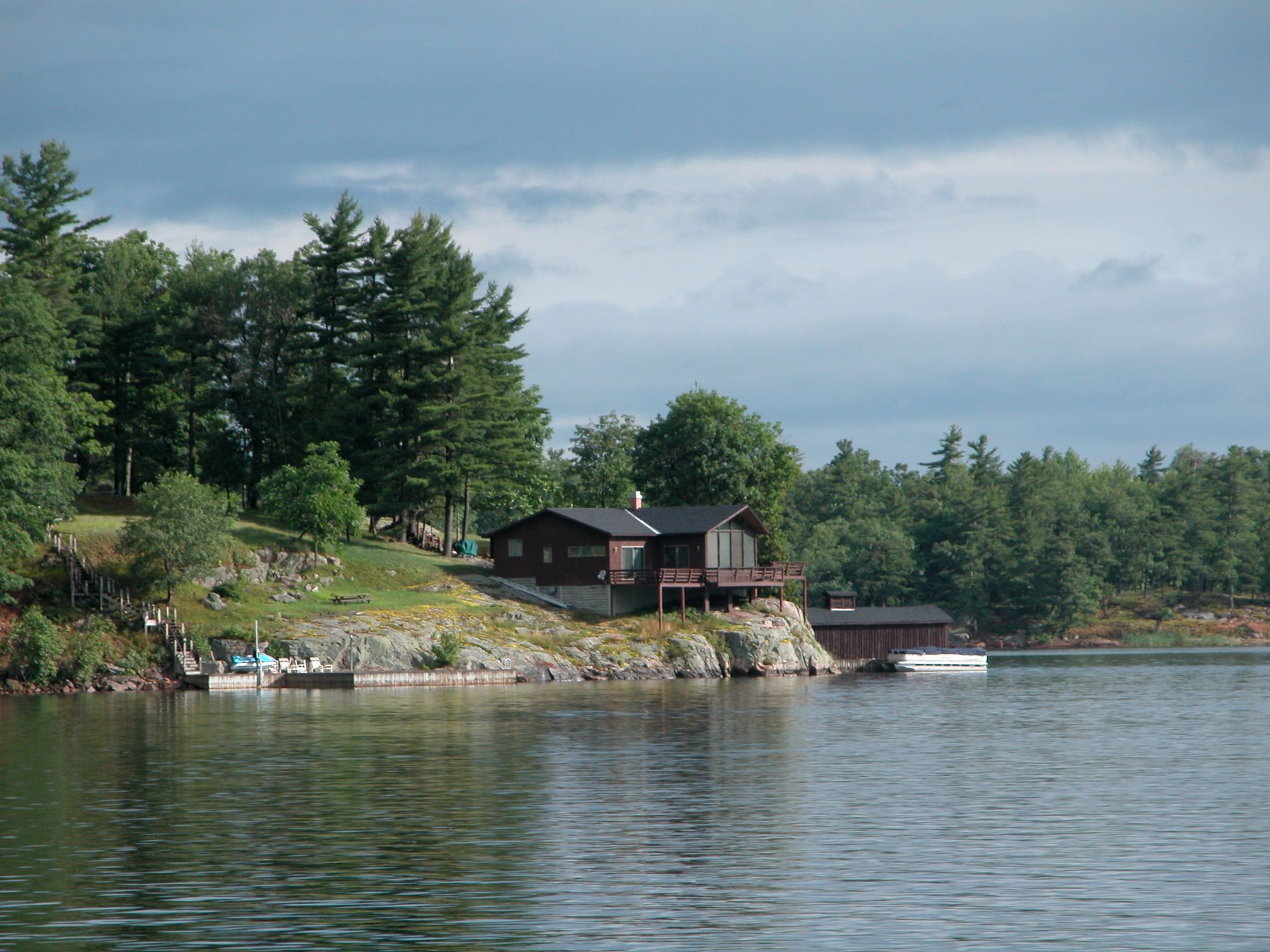
Demolished
When was the Cliff House torn down? Its demise like its inception is clouded in uncertainties. The last mention of it in the newspaper was in 1896. Margaret Nulty in her 1972 book Murray Isle reports that it was torn down sometime in the late 1890s.
The Mystery Fades
Once demolished, the tales of haunting faded. The memory of Cliff House and its haunted inhabitants have drifted away like early morning fog. Currently, there are two cottages near the point where the Cliff House once stood and I’ve often wanted to ask if the cottagers have ever experienced any paranormal phenomena. Now that I’m aware of all the legends, you can bet that the next full moon night, I’ll be looking out my bedroom window at the point directly across from me. Who knows! Perhaps I’ll see a ghostly parade.
By Lynn McElfresh, Grenell Island
Lynn came to Grenell Island for the first time to meet her fiancé’s family, in 1975. She became part of the family, and the island became part of her life. Lynn and her husband, Gary, spend their summers in the Thousand Islands and their winters in Dunedin, Florida. To see all of Lynn’s island experiences, search TI Life under Lynn McElfresh.


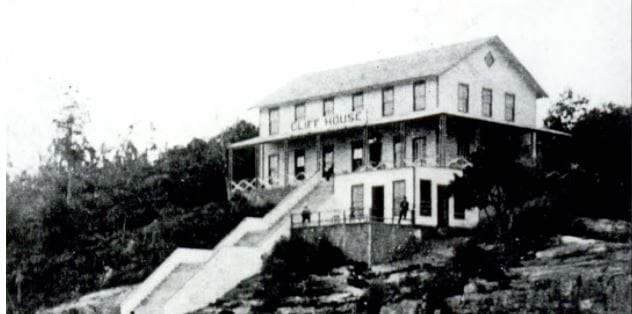



Please click here if you are unable to post your comment.